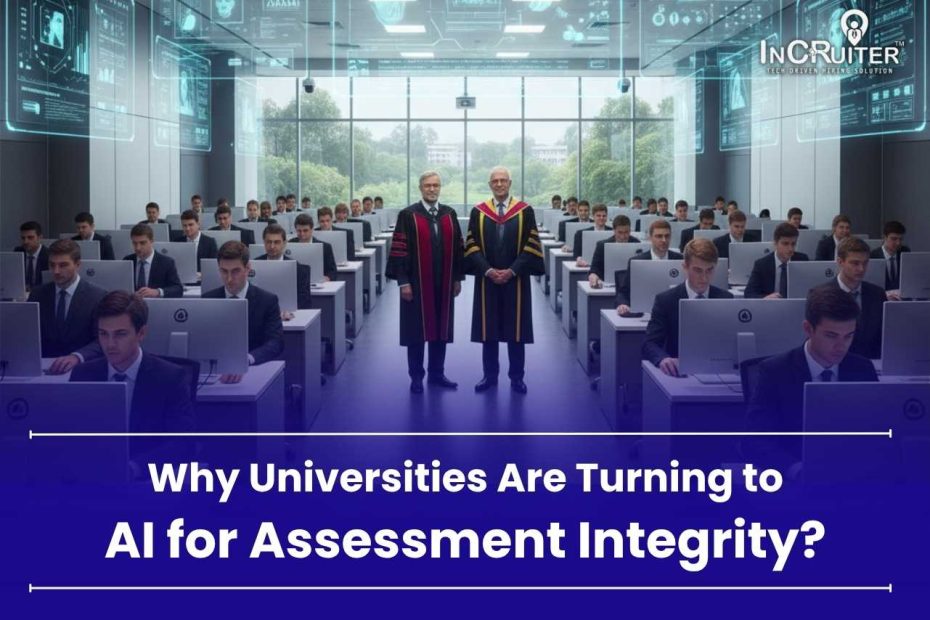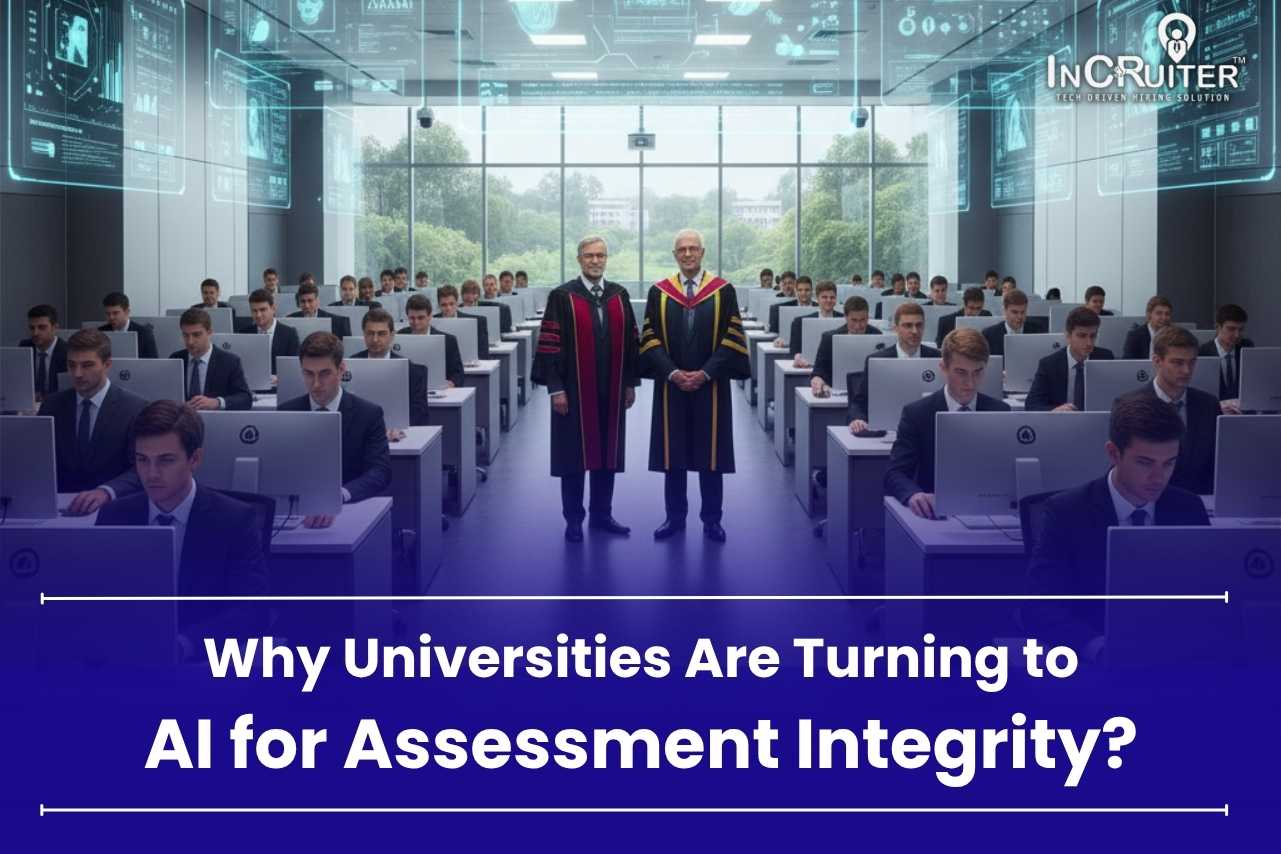Research shows that nearly 60% of students admit to cheating during online exams, a number far higher than in traditional classroom settings. For universities worldwide, this rising trend raises serious concerns about fairness, academic credibility, and the integrity of awarded degrees.
Traditional human-led invigilation has struggled to scale across geographies and large student volumes, leaving gaps that put institutions at risk. As digital education expands, universities are searching for reliable ways to secure their assessments.
In this blog, we examine why universities are adopting AI invigilance software, the features driving its adoption, and the academic benefits it delivers.
Integrity Challenge in Online Assessments Across Different Academic Scenarios
Entrance Tests
Remote national-level entrance exams struggle with identity verification, and many institutions report proxy log-ins. Self-report data shows that 44.7% of students admitted to cheating online, rising to 54.7% during COVID, highlighting how easily insidious breaches thrive in unguarded setups.
Coding Exams
During technical assessments, students frequently toggle between IDEs, browsers, or search engines. These covert behaviors weaken universities’ ability to judge true coding prowess, especially when nearly 60% admit to cheating most of the time in online exams.
International Admissions
Remote applicants span time zones and unstable networks, making real-time invigilation nearly impossible. Proctoring platforms’ own data shows a 6.6% confirmed breach rate, escalating to 7.2% in higher ed settings, a clear signal that even “proctored” environments aren’t immune.
Exchange Programs
Collaborative exams with partner institutions risk collusion via private messaging or shared online work. With nearly 60–70% of students in higher education admitting to academic dishonesty, joint programs face credibility risks if unchecked.
Scholarship Eligibility Tests
In high-stakes scholarship exams, students may use off-camera assistance or impersonation to gain an unfair advantage. With less than 2% of students ever caught, the vast majority of infractions go undetected, resulting in significant ethical and resource leakage.
Accreditation Exams
Remote professional assessments for law, nursing, and architecture leave vulnerabilities such as screen switching or impersonation. Any integrity breach here can derail program accreditation and tarnish institutional standing.
Online Degree Programs
Over extended durations, online degree assessments become targets for ongoing misconduct often coordinated on platforms like Discord or WhatsApp. Repeated lapses erode program trust, especially when large numbers self-report frequent cheating.
What Is AI Invigilance Software?
AI Invigilance Software is a digital monitoring system designed to safeguard the integrity of online exams and assessments. It uses artificial intelligence to oversee students remotely, identify irregular behaviors, and ensure fairness. Creating a secure virtual exam hall helps universities maintain credibility, trust, and compliance in remote evaluation environments.
Why Universities Are Adopting AI Invigilance?
Universities are rapidly shifting toward AI invigilance because it directly addresses the integrity gaps in online exams. Unlike traditional supervision, it scales to thousands of candidates while ensuring reliable oversight.
Key features making it indispensable include:
Identity Verification
Universities face the constant challenge of impersonation during online assessments. AI invigilance solves this through secure video interview links, ensuring only the genuine student participates. This feature builds confidence in admission tests, semester exams, and scholarship assessments, protecting academic credibility at every level of evaluation.
Location Tracking
Students appearing for exams from unknown or unauthorized locations is a growing concern. AI invigilance asks permission to share the candidate’s geolocation before proceeding with the online assessment to confirm they attempt the test from one location only. This prevents misuse of VPN, ensures compliance with institutional policies, and gives universities stronger control over remote assessments, even across borders and time zones.
Browser Lockdown
Tab switching and online searching are common tactics during digital exams. AI invigilance restricts browsing activity before starting the interview by locking the screen to the test interface. This eliminates unfair access to external resources, allowing universities to deliver exams that test genuine knowledge without interference from search engines or online notes.
Environment Scanning
Universities struggle with students using hidden notes, books, or devices in their exam surroundings. AI invigilance software scans the environment through the candidate’s webcam, flagging unauthorized items or people in the frame. This ensures that students attempt assessments under fair conditions, just like in a physical exam hall.
Gaze Tracking
Suspicious eye movements often reveal when a student is reading from off-screen materials. AI gaze tracking monitors focus and flags when candidates look away repeatedly. By identifying such behaviors, universities can maintain integrity in high-stakes exams where even subtle cheating can alter outcomes and compromise fair academic evaluation.
Dual Voice Detection
Whispers, background voices, or even family assistance during online tests often go unnoticed by human invigilators. AI audio monitoring detects such irregularities instantly. This feature helps universities protect exam fairness, especially in large-scale assessments where manual supervisors cannot track every candidate’s environment effectively through video alone.
Dual Face Detection
One of the biggest academic risks is when a proxy attempts the exam while the actual student is absent. AI invigilance uses dual face detection to flag multiple people in the frame. This ensures universities can prevent impersonation and uphold trust in their assessment outcomes.
Automated Flagging
Disputes often arise when students challenge malpractice allegations. AI invigilance addresses this by auto-flagging irregular behaviors with timestamped evidence. Universities receive audit-ready reports, enabling transparent review processes. This not only resolves conflicts fairly but also strengthens institutional reputation by proving exams are conducted with integrity and accountability.
These features ensure fairness, reduce malpractice, and protect the reputation of academic programs, making AI invigilance a trusted choice for universities.
Also Read: Campus Placement
Academic Benefits of AI Invigilance
1. Preserves Academic Integrity
The foremost benefit for universities is protecting the sanctity of assessments. AI invigilance ensures that grades and ranks truly represent student knowledge, upholding academic honesty across admissions, semester tests, and certifications.
2. Strengthens Institutional Credibility
A university’s reputation depends on the reliability of its results. By curbing impersonation and malpractice, AI invigilance safeguards the credibility of degrees and certifications, which is vital for attracting quality students and maintaining employer trust.
3. Ensures Fair Competition
Merit-based progression is central to higher education. AI invigilance creates equal conditions for every student, preventing dishonest candidates from gaining an unfair advantage and ensuring that scholarships, placements, and honors go to deserving learners.
4. Supports Academic Standards
As universities expand digital and global programs, AI invigilance makes sure online assessments match the rigor of campus-based exams. This prevents dilution of standards and allows institutions to confidently scale distance and hybrid learning.
5. Provides Evidence for Review
Universities often face grade appeals or malpractice disputes. AI invigilance generates audit-ready reports with detailed evidence, enabling academic councils to make transparent, defensible decisions rooted in facts rather than assumptions.
Use Cases in Academia
Universities around the world are embedding AI invigilance into important academic moments. In the United States, online MBA programs use it for midterm and capstone projects to ensure independent work. Australian institutions apply it in scholarship eligibility tests to protect merit-based awards.
European universities rely on it for joint assessments in cross-border exchange programs, while Asian universities use it for large-scale entrance exams in engineering and medicine, where thousands of applicants participate remotely.
These examples show how global academia depends on AI to safeguard integrity, for institutions and organizations looking beyond invigilation, from AI-powered interviews to coding assessments and remote proctoring, a complete set of solutions can be explored on the InCruiter Insights page.
Conclusion
Universities today operate in an era where academic integrity is under constant pressure, especially with the rise of online learning and digital examinations. Traditional methods of supervision often fall short, leaving institutions vulnerable to malpractice and credibility risks.
AI invigilance offers a strong alternative by creating assessments that are fair, secure, scalable, and trusted globally. It empowers universities to protect their reputation, uphold merit-based evaluation, and maintain the true value of their degrees.
Adopting advanced solutions like InCruiter AI Proctoring Software ensures every exam is conducted with transparency, reliability, and complete confidence in academic outcomes.



















